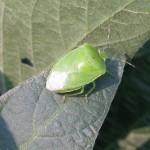Don’t Forget the UT Soybean Scout Schools Next Week! These are 1.5 – 2 hour programs dealing with crop and pest management. Scouting notebooks and sweep nets will be provided while Continue reading
Category Archives: Soybean
Should Weed Control be Suspended due to the Drought?
The drought of 2012 is shaping up to be one of those widespread tough ones no one forgets, like 1983 or 1988. Hopefully, we will get a good general rain here shortly. This drought has been the source of calls from frustrated folks who are still trying to control Palmer amaranth. The question has been asked should I discontinue weed control with the yield potential of my crops going down every day. Continue reading
Crop Progress
As reported by NASS on July 2, 2012
OPPRESSIVE HEAT AND BRUTALLY DRY CONDITIONS
CONTINUE TO STRIKE TENNESSEE FARMLAND
The hottest temperatures on record coupled with no precipitation last week led to a deterioration of crop conditions throughout the state. Topsoil moisture supplies are rated short or very short on 94 percent of Tennessee farmland. The corn and pasture acreages are especially affected, as almost half the corn is rated in very poor or poor condition with two-thirds of the pastures in this same category. Soybean, tobacco, and cotton acreage remained in mostly fair-to-good condition but declined substantially in one week. Pastures are parched and livestock producers are feeding hay, an event that normally begins in the fall. Continue reading
Revisiting Irrigation for Corn and Soybean
Irrigation equipment is running non-stop as water use really ramps up for corn and soybeans. I am including approximate amounts to water each week for post silking corn and beans that are entering the reproductive stages. Continue reading
Crop Progress
As reported by NASS on June 25, 2012
DRY CONDITIONS PREVAILING
The high pressure system holding over Tennessee caused a continuation of the hot and dry weather last week. Virtually all of the featured weather stations across the state now show considerable precipitation deficits indicating moderate drought conditions. Soil moisture reports indicate that moisture levels in the state were 60 percent short to very short in West Tennessee, 80 percent short to very short in Middle Tennessee, and 70 percent short to very short in East Tennessee. The effects of the extended dry spell on crops have begun to show, but most crops continue to be rated in fair-to-good condition. Corn development remains well ahead of normal with seventy percent in the silking stage, but plants are twisting in many areas. Continue reading
Soybean Scout Schools in July
Mark your calendars for Soybean Scout Schools in West and Middle Tennessee. The tentative schedule is listed below. More details will be announced later. This is your opportunity to learn more about crop and pest management in a hands-on program that last 1.5 – 2 hours. Continue reading
Stink Bugs in Soybean and R3 Insecticide Sprays with Fungicide
Stink Bugs. Thus far stink bug populations in soybean appear to be relatively low. In particular I have not seen or heard many reports of green stink bugs, which is usually our primary species. At this time of year, they often concentrate in the earliest soybean fields (those setting pods).
Our treatment threshold for stink bugs in soybean changed a couple of years ago. UT now suggests a threshold of 36 stink bugs per 100 sweeps from R1 to R7 . Continue reading
Crop Progress
As reported by NASS on June 18, 2012
RAIN PROVIDED RELIEF IN SOME AREAS; CONTINUED DRY IN OTHERS
The weather pattern of scattered showers continued last week leaving 46 percent of Tennessee farmland short of soil moisture at week’s end. Crops continued to hold in mostly good condition. Forty-seven percent of the corn crop is in the critical pollination stage. Wheat harvest, soybean planting and tobacco transplanting are now about finished. Full-season soybeans are beginning to bloom and almost a third of the cotton crop is entering the squaring stage of development. As the hot Continue reading


